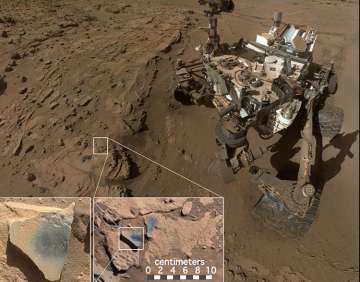Washington: NASA's Curiosity rover has observed high levels of manganese oxides in Martian rocks which suggests that the Red Planet once had more oxygen in its atmosphere than it does now.
The discovery tells that Mars exhibits more Earth-like properties than previously believed.
Researchers found high levels of manganese oxides by using a laser-firing instrument on the rover. This hint of more oxygen in Mars' early atmosphere adds to other Curiosity findings -- such as evidence about ancient lakes -- revealing how Earth-like our neighboring planet once was.
The manganese oxides were found in mineral veins within a geological setting the Curiosity mission has placed in a timeline of ancient environmental conditions. From that context, the higher oxygen level can be linked to a time when groundwater was present in the rover's Gale Crater study area.
"The only ways on Earth that we know how to make these manganese materials involve atmospheric oxygen or microbes," said Nina Lanza, planetary scientist at Los Alamos National Laboratory and lead author on the study.
"Now we're seeing manganese-oxides on Mars and wondering how the heck these could have formed," she added in a paper appeared in the journal Geophysical Research Letters.
"These high manganese materials can't form without lots of liquid water and strongly oxidizing conditions. Here on Earth, we had lots of water but no widespread deposits of manganese oxides until after the oxygen levels in our atmosphere rose," she said.
To reach this conclusion, Lanza used the Los Alamos-developed ChemCam instrument that sits atop Curiosity to "zap" rocks on Mars and analysed their chemical make-up.
In less than four years since landing on Mars, ChemCam has analysed roughly 1,500 rock and soil samples.
"These high-manganese materials can't form without lots of liquid water and strongly oxidizing conditions," said Lanza.
"Here on Earth, we had lots of water but no widespread deposits of manganese oxides until after the oxygen levels in our atmosphere rose due to photosynthesizing microbes," the author noted.
One potential way that oxygen could have gotten into the Martian atmosphere is from the breakdown of water when Mars was losing its magnetic field.
"It's thought that at this time in Mars' history, water was much more abundant," said Lanza.
The next step is for scientists to better understand the signatures of non-biogenic versus biogenic manganese, which is directly produced by microbes.
If it's possible to distinguish between manganese oxides produced by life and those produced in a non-biological setting, that knowledge can be directly applied to Martian manganese observations to better understand their origin.
Latest World News
